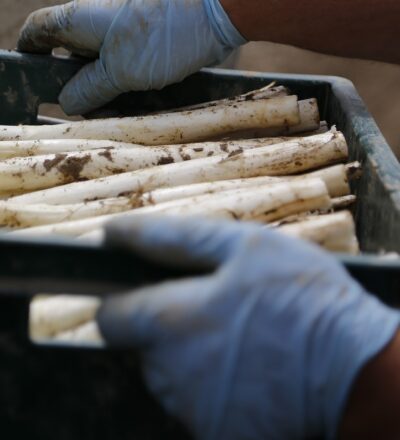The project Waste2Taste aims to reduce agricultural waste by using vegetable waste streams to generate high quality dried powders. One of the researchers of this project is Joanne Siccama from Wageningen University. She discovered that the residual flow of white asparagus is very suitable for spray-drying into powder. The aroma that ends up in asparagus soup powder is preserved much better than with traditional hot air drying.
What is now killing the taste of current soup powders is the way vegetables are processed. Manufacturers use fresh vegetables, chop them up and dry them for a long time using hot air under high temperature. The problem with this drying process is that the vegetables lose much of their aroma and flavour: these evaporate along with the moisture in the drying tunnel. To prevent this, spray drying is applied. This is a proven technique for generating powders, for example for the production of milk powder, but not yet for drying vegetables.
3.000 tons of asparagus waste
An important aspect of the Waste2Taste project is processing residual streams to prevent food waste. For this study, Siccama looked at the end of white asparagus, which are left behind after the grower cuts them to size. As a result, about 15% of the stem is lost. The back ends are discarded, or used as compost. In total, this concerns about 3.000 tons of asparagus waste per year that is available from Dutch growers and could be used.
Asparagus juice
To process the asparagus, a split-stream process is used to separate the juice from the fibre fraction. Then the juice is concentrated by membranes. This technique has not been used before to make soup powder. According to Siccama, concentrating via evaporation was not a good option because you will lose aromas. The somewhat thick, sticky concentrated juice that remained created a challenge to spray-dry into a powder. Therefore, maltodextrin was used as a carrier. This substance is easily soluble and reduces stickiness so a nice powder could be obtained.
A richer aroma by spray-drying
The powders were analyzed in several ways, including chemical analysis by researcher Eirini Pegiou. All the flavours were mapped by gas chromatography. This made it possible to determine what is in the juice before it enters the spray dryer and shows how many flavours the final product contains. Hardly no flavours were lost after drying.
The question: is the result actually tastier than asparagus soup made from traditional dried powder? A test panel liked Siccama’s version better. The soup has a richer asparagus aroma and more asparagus characteristics. This confirms that this method works and offers opportunities for the future.
This article previously appeared in:
Het Parool: Minder verspilling, meer aspergesmaak (in Dutch)
Food AgriBusiness: Onderzoek WUR: sproeidrogen van aspergeafval leidt tot aromatisch poeder (in Dutch)
Acknowledgement
This project is co-funded by TKI-E&I with the supplementary grant 'TKI- Toeslag' for Topconsortia for Knowledge and Innovation (TKI’s) of the Ministry of Economic Affairs and Climate Policy.
